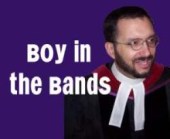I like open source software. It is usually financially free, and while I don’t develop software, I do benefit from those who use the freedom is provides. When InfoCentral, a church and not-for-profit management software project decided to follow a Java development line, some other people forked its development (under the name ChurchInfo using a scripting language (PHP) I have a better understanding of.
Open source software is a model of progress and collaberation. I like it very much, and admire the values it tends to cultivate.
Now, what about worship in the mainline churches, by which I include Unitarian Universalism?
There a practice I have seen in Unitarian Universalist pulpits that annoys me. It isn’t so much the elevating fragments of colleague’s sermons as “readings” (which isn’t so hot) but the endless attribution. Worship begings to sound like a term paper with footnotes.
So, let me cut to the point. Who owns — intellectually owns — worship?
In “modern” churches, even those that biblical readings and not the above situation, who owns the pieces? Modern translations of the Bible are under copyright. Modern prayers are under copyright. New hymns — all since 1923, unless released into the public domain — are under copyright. Likewise the choral and instrumental music. Of course, the sermon is under copyright. For those churches that use them, the modern English versions of the ecumenical creeds are under copyright, plus any denominational confessions. I’m pretty sure the Revised Common Lectionary is under copyright, its use on a number of websites not withstanding. Someone owns just about everything we do on Sunday.
That bothers me. Faithful people — here read Christian or Unitarian Universalist depending on how you got to this site — in communion need the sources of their faith to be held in common trust without ownership. Which begs a question: who owns the much-quoted Principles and Purposes? Does anyone?
Now, here’s the exception that proves the rule. The Episcopal Book of Common Prayer — the American one is the one I mean here, but there are others — is not in copyright. If you have one, grab it and look for a copyright page. (Hint: there isn’t one.)
I suspect that’s why when there’s ever been a “default liturgy” needed in a non-liturgical church (and I use that term advisedly, since all churches have a liturgy though not a set or printed one) the Episcopalians have been brought to use.
I suspect that’s why, except for the historically singular exception of King’s Chapel (and its former chapel, First Church in Chestnut Hill), that “liturgical” Universalist and Unitarian rites have pulled more from the Episcopalians than the “Puritan style” or even high Reformed rites.
So, what could be a commonly-owned common core? And how would we acquire one?
Here’s the irony: the most conservative Protestant churches — using old hymns and forms, and reading the King James Version of the Bible — already have one.
Now I want an open-source core for the faith, too.


